#Nir Distelfeld
Explore tagged Tumblr posts
Text
Tredicenne trova un anello romano durante un'escursione: "È del III secolo e rappresenta la dea Atena"
Tredicenne trova un anello romano durante un'escursione: "È del III secolo e rappresenta la dea Atena"
Elena Percivaldi Oltre ad essere salutare, fare una semplice passeggiata può a volte portare a risultati inaspettati, meglio ancora a fare intriganti scoperte. È quel che è accaduto a Yair Whiteson, un tredicenne di Haifa, che stava facendo un’escursione vicino al sito della “cava antica”, nei pressi del sito di Khirbet Shalala sul Monte Carmelo in Israele, quando si è imbattuto in un piccolo…
#archeologia#Bar-Ilan University#Eitan Klein#Israel Antiquities Authority#Israele#Khirbet Shalala#Monti del Carmelo#Nir Distelfeld#notizie#Palestine Exploration Fund#scavi#scavi archeologici#scoperte#Shua Amorai-Stark
0 notes
Text

Teen Discovers 1800-Year-Old Ring Engraved with Goddess Athena on Mount Carmel
The artifact was examined with the assistance of Prof. Shua Amorai-Stark, an expert on ancient rings and amulets from the Kaye Academic College.
A Haifa teenager recently discovered an ancient engraved ring while hiking on Mount Carmel in northern Israel, according to the Israel Antiquities Authority (IAA). The ring, which is engraved with the image of Athena, the Greek goddess of war, has been handed over to the IAA and is set to be displayed in Jerusalem.
This July, 13-year-old Yair Whiteson's discovery will be displayed at the Jay and Jeanie Schottenstein National Campus for the Archaeology of Israel in Jerusalem.
The teen's interest in fossils and rocks helped lead to this shocking discovery. When he made the discovery, Whiteson was hiking near the ancient quarry site below Khirbet Shalala with his father, who had recently returned from four months of army reserve duty. The teen noticed a small green object, initially mistaken for a rusty bolt. After closer inspection, he realized it was a corroded ring with an engraved image.
“At first glance, I thought it was a warrior,” Yair said.

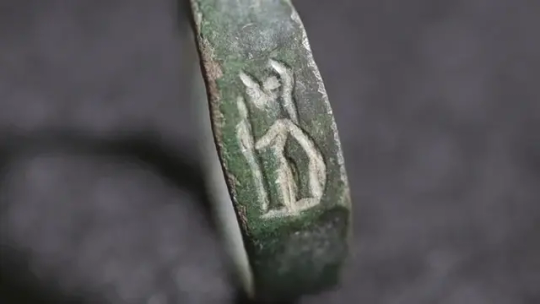
The family contacted Nir Distelfeld, an inspector at the IAA’s Theft Prevention Unit, who quickly arranged for the object to be transferred to the National Treasures Department. The artifact was then examined with the assistance of Prof. Shua Amorai-Stark, an expert on ancient rings and amulets from the Kaye Academic College.
“On this beautifully preserved ring is the image of a helmeted naked figure holding a shield in one hand and a spear in the other,” explained Distelfeld and Dr. Eitan Klein from the IAA's Unit for the Prevention of Antiquities Robbery.
“Yair's identification of the figure as a warrior was close; it is likely the goddess Minerva from Roman mythology, known as Athena in Greek mythology. This goddess, popular during the Roman period in the Land of Israel, was considered the goddess of war and military strategy, as well as wisdom.”


Anicent archaeological discovery made by young teen
The bronze ring dates back to the 2nd-3rd Century CE - the Late Roman Period. It was believed to have belonged to a female, possibly a farmstead resident, a quarry worker, or even as a burial offering in a nearby cave.
Khirbet Shalala, the archaeological site near the discovery, is situated on a hilltop in the Carmel Mountains, surrounded by Nahal Oren and near the perennial water source Ein Alon. Various archaeologists have explored the site, including 19th-century Palestine Exploration Fund surveyor Prof. Ruth Miran and a Bar-Ilan University expedition led by Prof. Shimon Dar.
Visitors to the Jay and Jeanie Schottenstein National Campus for the Archaeology of Israel can revel in ancient history through IAA tours throughout the summer.
#Teen Discovers 1800-Year-Old Ring Engraved with Goddess Athena on Mount Carmel#Mount Carmel#Minerva#Athena#ring#ancient jewelry#archeology#archeolgst#history#history news#ancient history#ancient culture#ancient civilizations#roman history#roman empire#roman mythology#greek mythology
43 notes
·
View notes
Text
Reliquias de piedra antiguas descubiertas en Escocia e Israel
Reliquias de piedra antiguas descubiertas en Escocia e Israel
View On WordPress
#antiguas#asedio medieval#autoridad de antigüedades unidad de prevención de robo#bala de cañón#beit she’an#bustos de piedra#bustos romanos#castillo de Edimburgo#de#descubiertas#Eitan Klein#en#Escocia#Israel#misterios antiguos#nir distelfeld#Noticias#piedra#reliquias#reliquias de piedra
0 notes
Text
900-Year-Old Crusader Sword Found Covered in Barnacles Off Israel Coast
https://sciencespies.com/humans/900-year-old-crusader-sword-found-covered-in-barnacles-off-israel-coast/
900-Year-Old Crusader Sword Found Covered in Barnacles Off Israel Coast

Fish swimming off the Carmel coast in western Israel may have been alarmed last Saturday to spot a scuba diver kicking through the water with a large, barnacle-encrusted sword in hand.
The diver — a hobbyist named Shlomi Katzin — had just discovered a trove of 900-year-old artifacts on the Mediterranean Sea bed, apparently dating to the region’s bloody crusader period, the Israel Antiquities Authority (IAA) said in a statement on Monday (Oct. 18).
The sword, which was “encrusted with marine organisms,” is believed to be made of iron and measures approximately 3.3 feet (1 meter) long, with a hilt measuring an additional 1 foot (30 centimeters) in length, according to the IAA.

The sword, as diver Katzin found it. (Shlomi Katzin)
Related: The 25 most mysterious archaeological finds on Earth
“The sword, which has been preserved in perfect condition, is a beautiful and rare find and evidently belonged to a Crusader knight,” Nir Distelfeld, Inspector for the Israel Antiquities Authority’s Robbery Prevention Unit, said in the statement.
“It is exciting to encounter such a personal object, taking you 900 years back in time to a different era, with knights, armor and swords.”

The barnacle-encrusted blade. (Shlomi Katzin)
Near the site where the sword was discovered, Katzin also stumbled upon an assortment of stone and metal anchors, as well as fragments of pottery.
Previous archaeological finds in the area suggest that the cove was used as a natural anchorage for ships seeking shelter and has been in use since the Late Bronze Age, at least 4,000 years ago, according to the IAA.
While many artifacts line the seabed, the constant movement of water and sand throughout the Mediterranean means discoveries like these ultimately come down to luck.
“Even the smallest storm moves the sand and reveals areas on the sea bed, meanwhile burying others,” said Kobi Sharvit, Director of the IAA Marine Archaeology Unit.
“It is therefore vitally important to report any such finds and we always try to document them in situ, in order to retrieve as much archaeological data as possible.”

Nir Distelfeld with the Crusader sword (Anastasia Shapiro/Israel Antiquities Authority)
Katzin was awarded a certificate for bringing the find to the IAA’s attention (and for not adding the medieval blade to his personal trophy shelf). The sword will go on public display following a thorough study, the IAA said.
The Crusades lasted from roughly 1095 to 1291. During this time, many European knights traveled to the Holy Land on a church-sanctioned quest to reclaim the area from Muslim rulers. Grisly archaeological finds from the period are regularly uncovered throughout the Middle East.
Related Content:
Photos: Parasite eggs found hiding in 500-year-old Jerusalem latrine
Cracking codices: 10 of the most mysterious ancient manuscripts
Image gallery: Medieval art tells a tale
This article was originally published by Live Science. Read the original article here.
#Humans
0 notes
Text
4500 éves cserépedényeket talált egy arab villanyszerelő
4500 éves cserépedényeket talált egy arab villanyszerelő
Észak-Izraelben 4500 éves cserépedényeket és egy tőr pengéjét találta meg véletlenül egy villanyszerelő – jelentette a Háárec című újság honlapja.
Az Ahmad Naszer Jaszin nevű becsületes megtaláló egy frissen megépített föld��ton tartott múlt pénteken az Arraba nevű, nyugat-galileai arab faluban rá váró munkái felé, amikor egy sziklamélyedésből kiálló cserépfülre lett figyelmes.
Közelebb ment, és…
View On WordPress
0 notes
Text
Security Officers Prevent Two Archeological Thefts
New Post has been published on http://hamodia.com/2017/12/15/security-officers-prevent-two-archeological-thefts/
Security Officers Prevent Two Archeological Thefts
Archaeological site. (Guy Fitoussi, courtesy of the IAA.)
This week was a particularly busy one for the security forces of the Archaeological Authority. In the space of just a few hours Wednesday night, the forces caught two gangs that were in the midst of trying to steal archaeological treasures, which would be worth tens of thousands of dollars on the private market.
Security forces, acting on a tip, caught a gang digging in a 2,000-year-old cave outside the Galilee Arab village of Ma’ar. The cave was the site of discovery of relics from the first century CE, the Roman occupation of Eretz Yisrael.
The relics include carved inscriptions, jugs, jewelry, and items associated with the Sixth Roman Legion, which was stationed in the area. The gang was caught in the midst of an illegal digging operation, led by a resident of Ma’ar. The ringleader was arrested, but at least two of his criminal associates absconded. Officials were searching for them.
In a second incident, officers discovered a group of five suspects who were operating in the area of Churbat Devorah, adjacent to the Arab village of Kfar Daburiyah. Churbat Devorah was the site of a Talmudic-era village, and contains antiquities from that period, as well as from later periods. Antiquities from the Hellenstic period (the period of nes Chanukah) have been found there as well. The gang was found digging illegally at the site, damaging several structures that were uncovered by archaeologists.
Nir Distelfeld, supervisor of the Authority’s antitheft unit in the north, said that “the story of a nations is based on the treasures of its past. Time after time we find thieves looking to get rich off the treasures that were buried here in the past. They are doing this at our expense, stealing our past. It is sad that the greed for money causes people to be so blind. These illegal digs cause irreparable damage, harming the historical investigation that is important to all of us.”
0 notes
Text
Archeologia / Trovato in Galilea un antico sigillo a forma di scarabeo: ha 2.800 anni, risale al dominio assiro e presenta un grifone inciso
Archeologia / Trovato in Galilea un antico sigillo a forma di scarabeo: ha 2.800 anni, risale al dominio assiro e presenta un grifone inciso
Elena Percivaldi Un antichissimo sigillo a forma di scarabeo, risalente al periodo del Primo Tempio, circa 2.800 anni fa, è tornato alla luce casualmente nella Bassa Galilea, in Israele. A trovarlo è stato un escursionista, il 45enne Peudel Erez Avrahamov, che con sua grande sorpresa si è imbattuto nel reperto mentre percorreva un sentiero nella Riserva Naturale del Torrente Tabor. Il…
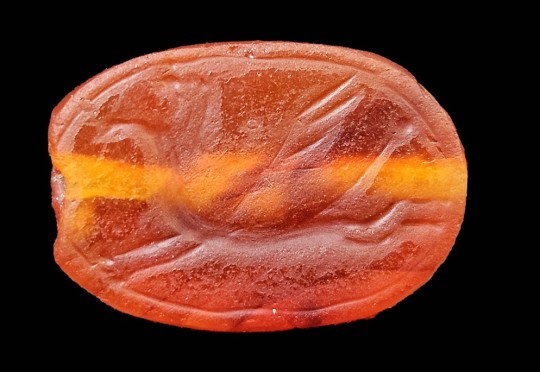
View On WordPress
#Antichità#archeologia#Assiri#Galilea#in ev#In evidenza#Israel Antiquities Authority#Israele#Nir Distelfeld#notizie#Othmar Keel#Primo Tempio#scarabeo#scoperte#sigillo#sigillo scarabeo#Tabor#Tel Rekhesh#Vicino Oriente
0 notes
Photo





Diver Discovers a 900-Year-Old Crusader Sword Off Israel’s Coast
The four-foot-long weapon is encrusted in marine organisms but otherwise in “perfect condition”.
A man diving off the coast of northern Israel, not far from his home, recently stumbled onto a 900-year-old sword dated to the time of the Crusades. Shlomi Katzin, a resident of the town of Atlit, spotted the sword and other centuries-old artifacts on the sea bed off the Carmel coast, where shifting sands had apparently made them suddenly visible, reports Nicky Blackburn.
The four-foot-long sword was covered in shells and other remnants of sea life. Katzin reported the discovery to the Israel Antiquities Authority’s (IAA) robbery prevention unit.
“The sword, which has been preserved in perfect condition, is a beautiful and rare find and evidently belonged to a Crusader knight,” says IAA inspector Nir Distelfeld in a statement. “It was found encrusted with marine organisms, but is apparently made of iron. It is exciting to encounter such a personal object, taking you 900 years back in time to a different era, with knights, armor and swords.”
Archaeologists had already been monitoring the area, a natural cove that offered shelter to ships for millennia, before Katzin’s find, reports Stuart Winer for the Times of Israel. Earlier discoveries have shown that the site was active as long as 4,000 years ago.
Unpredictable conditions in the ocean often bring artifacts to the surface; a rise in the number of people diving recreationally in the area means that more of these objects have reemerged in recent years, says Koby Sharvit, director of the IAA’s marine archaeology unit, in the statement.
“Even the smallest storm moves the sand and reveals areas on the seabed, meanwhile burying others,” Sharvit adds.
In addition to the sword, Katzin spotted pottery fragments and stone and metal anchors, per the Jerusalem Post’s Rossella Tercatin.
Starting in the 11th century, leaders of European nations and the Roman Catholic Church sent Crusader armies to the Middle East to seize sites considered holy by Christians from Muslim rulers. After the Muslim sultan Saladin retook Jerusalem from the Crusaders in 1187, England’s Richard I led an army against him, traveling south along Israel’s coast from Acre to Jaffa and winning what Richard Spencer of the London Times deems a “great but ultimately pyrrhic victory.”
Since the sword is still covered in encrustations, it’s impossible to say much about it, Sa’ar Nudel, an archaeologist who studies weapons from the Crusades, tells Haaretz’s Ruth Schuster. The Crusaders and their Muslim Ayyubid and Mamluk opponents all typically used straight swords of similar size and shape, archaeologist Rafi Lewis adds.
“The basic shape of the weapon, a straight sword, didn’t evolve much from the time of the Vikings to the 14th century,” he tells Haaretz.
According to Sharvit, the fact that the sword was found more than 600 feet from the coast suggests it was a Crusader’s weapon. Muslim forces built fortifications along the coast as defenses against arriving Christian forces but didn’t travel by sea themselves.
“They destroyed the coastal cities so the Crusaders couldn’t return and reconquer the Holy Land,” the archaeologist says to Haaretz.
The sword is now in the hands of the IAA’s National Treasures Department, per Israel 21c. IAA scientists plan to clean and study the weapon before putting it on display to the public.
By Livia Gershon.
#Diver Discovers a 900-Year-Old Crusader Sword Off Israel’s Coast#crusaders#archeology#history#history news#holy land#treasure
667 notes
·
View notes
Photo
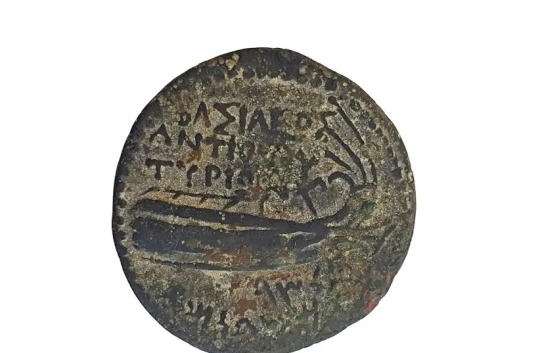
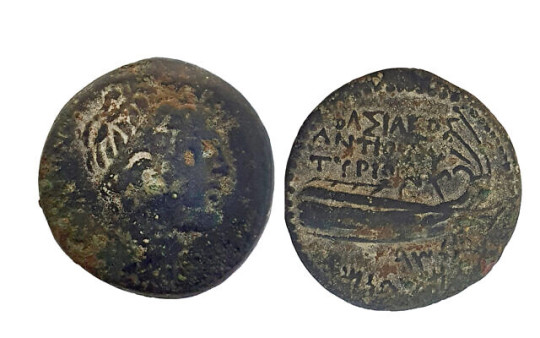
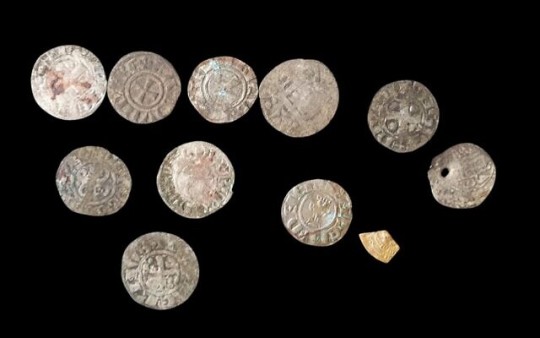

A Rare Looted Coin of Hanukkah Villain Found in Israel
Currency bearing visage of King Antiochus IV discovered in home of Kiryat Shmona man caught ‘in the act’ of illegally using metal detector at northern archaeological site.
A house search of a suspected artifact thief in the northern town of Kiryat Shmona led to the discovery of illegally obtained artifacts on Wednesday, most notably a coin depicting the Seleucid King Antiochus IV, the villain of the Hanukkah story, the Israel Antiquities Authority said.
According to Danny Synon, an IAA coin specialist, the bronze coin found at the suspect’s home was minted in Tyre, today part of Lebanon, and was “common currency” during the era.
It was the “small change” of the day and hundreds of such coins have been found in digs throughout Israel, Synon said.
While it is impossible to know how much the coin was worth during the reign of Antiochus IV, it would have been used to purchase everyday items from the local market, he said.
“I can’t say whether it was worth a loaf of bread or a chicken, but something along those lines,” said Synon.
The suspect, 33, was caught “in the act” by Border Police, who found him illegally using a metal detector at a registered archaeological site in Ramot Menashe in northern Israel.
“He was detained for questioning, and in his bag were found ancient coins, various digging implements, and a metal detector,” the IAA said in a statement.
The IAA’s Department for the Prevention of Archeological Theft then conducted a search of the man’s house, finding the coin in addition to “arrowheads, rings, cosmetic spoon, buckles, lead objects, buttons and more.”
The suspect was released following questioning, and his metal detector was confiscated. The IAA is weighing whether to press charges, the statement read.
If convicted, those guilty of collecting antiquities at registered sites can be jailed for three years.
“The suspect claimed that he was interested in geology, and was looking for quartz crystals and metals, and ‘by the way’ he collected coins and other ancient finds,” said Nir Distelfeld, the IAA’s northern area inspector of the Department for the Prevention of Archaeological Theft.
Distelfeld noted that the discovery of the Antiochus IV-era coin was made shortly before Hanukkah, the eight-night Jewish festival set to begin on December 18.
Antiochus IV was a Seleucid monarch remembered in Jewish history for his promotion of Hellenization and suppression of religious observances. While he was battling the rival Ptolemaic kingdom in Egypt for control of the Levant, Jewish zealots rose in revolt against Antiochus and the Hellenized high priest installed in Jerusalem’s Second Temple.
Antiochus returned from Egypt and attempted to quell the uprising. After his death on a subsequent campaign in Persia, Hasmonean rebels led by Judah Maccabee and his clansmen succeeded in wresting control of Judea from the Seleucid Greeks, restoring the temple and forming a Jewish kingdom that ruled for a century. The Hanukkah holiday celebrates the Maccabees’ victory over the Greeks and Hellenized Jews.
According to Synon, what is unique about the currency series that the bronze Antiochus IV coin is part of is that they were minted during what he calls an “economic experiment” conducted by the monarch in which he allowed four municipalities to mint their own local coinage.
One side of the “municipality coin” usually featured a local god, said Synon, and the other side was engraved with an image connected to the local area. In the case of the recently recovered coin, one side features the king, and the other shows a ship and the name of the port city of Tyre.
“Stealing remains from ancient sites negates the possibility of researching the finds and the sites in their true archaeological historical context, thus withholding valuable knowledge from researchers and the entire community,” IAA director Eli Escusido said in a statement.
#A Rare Looted Coin of Hanukkah Villain Found in Israel#King Antiochus IV#Hanukkah story#Ptolemaic kingdom#collectable coins#ancient coins#ancient artifacts#metal detector#metal detecting finds#archeology#archeolgst#history#history news#ancient history#ancient culture#ancient civilizations
17 notes
·
View notes
Photo

Very Rare Ancient Coin with the Head of Zeus Found in Israel
A rare coin, dated back to about 2,300 years ago, was discovered near the Arab city of Umm al-Fahm in northern Israel, the Israel Antiquities Authority (IAA) said Friday.
It was found by police officers, who discovered two young men with shovels and metal detectors in a forest northeast of the city. In a search of the two young men’s car, the officers found ancient coins, including the rare one, said the IAA.
One side of the coin bears the head of the Greek god Zeus, turned to the right, while the other side is decorated with an eagle with wings closed standing on a bundle of lightning, and around it the name of King Ptolemy was engraved in Greek letters.
Nir Distelfeld, inspector for the IAA’s robbery prevention unit, told Xinhua that the coin was probably minted in Alexandria in Egypt, as during the Hellenistic period, Alexandria was an international trading city and a manufacturing center.
#Very Rare Ancient Coin with the Head of Zeus Found in Israel#King Ptolemy#Hellenistic period#Alexandria#Greek Gods#archeology#metal detector#history#history news#ancient history#collectable coins#treasure
16 notes
·
View notes
Text
Clay Oil Lamp From Chashmona’im Period Discovered
New Post has been published on http://hamodia.com/2017/12/12/clay-oil-lamp-chashmonaim-period-discovered/
Clay Oil Lamp From Chashmona’im Period Discovered
The clay lamp. (Miki Peleg, Israel Antiquities Authority)
Just in time for Chanukah, a pottery vessel archeologists believe dates to the historic period of the Chanukah events was discovered in the Beit Shean Valley.
The clay oil lamp was stumbled upon by Ayelet Goldberg-Keidar and her daughter Hadas, residents of Kibbutz Beit Alfa, while on a stroll in the area about a week ago.
Seven-year-old Hadas picked up the vessel and her mother – who happens to be an archaeology student at Haifa University – realized right away that the lamp could well have historic value.
“Guessing that this was connected to antiquity theft, I hurried to get in touch with the theft prevention unit at the Israel Antiquity Authorities (IAA),” said Ms. Goldberg-Keider.
IAA theft prevention inspector Nir Distelfeld had a more mundane explanation for the item’s exposure:
“Innocent porcupines, digging out their den for the winter, are responsible for the excavation of this intact lamp,” said Distelfeld. “Porcupines prefer archaeological sites because the earth is less packed due to man’s activities in the past.”
The judgment of Dr. Einat Ambar-Armon, an expert in clay lamps, was that it came from the Chashmona’im period.
“The lamp is typical of the Hellenistic period, which began in the 2nd century BCE, the historical period that is known to all of us as the Maccabean Wars against the Greeks,” said Ambar-Armon, the IAA’s regional head of education and community outreach.
During this period, said Ambar-Armon, such lamps were produced from molds: the top and bottom pieces were constructed separately and then connected in a new technique that allowed for their mass production, which she attributes to western-influenced innovation.
The IAA announced it will present the Goldberg-Keidar family with a certificate of appreciation for good citizenship in bringing the find to their attention and donating the lamp to the IAA.
0 notes